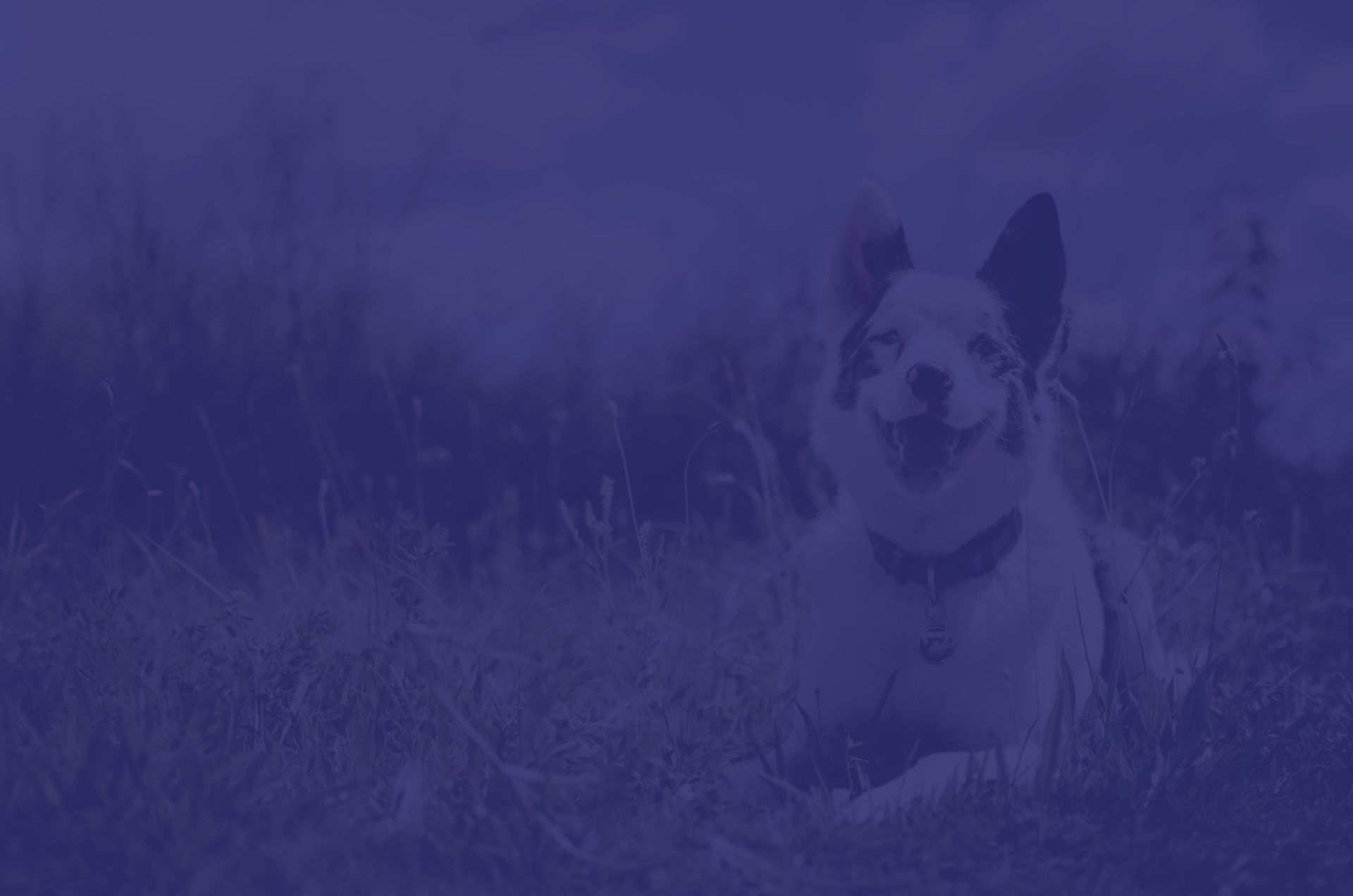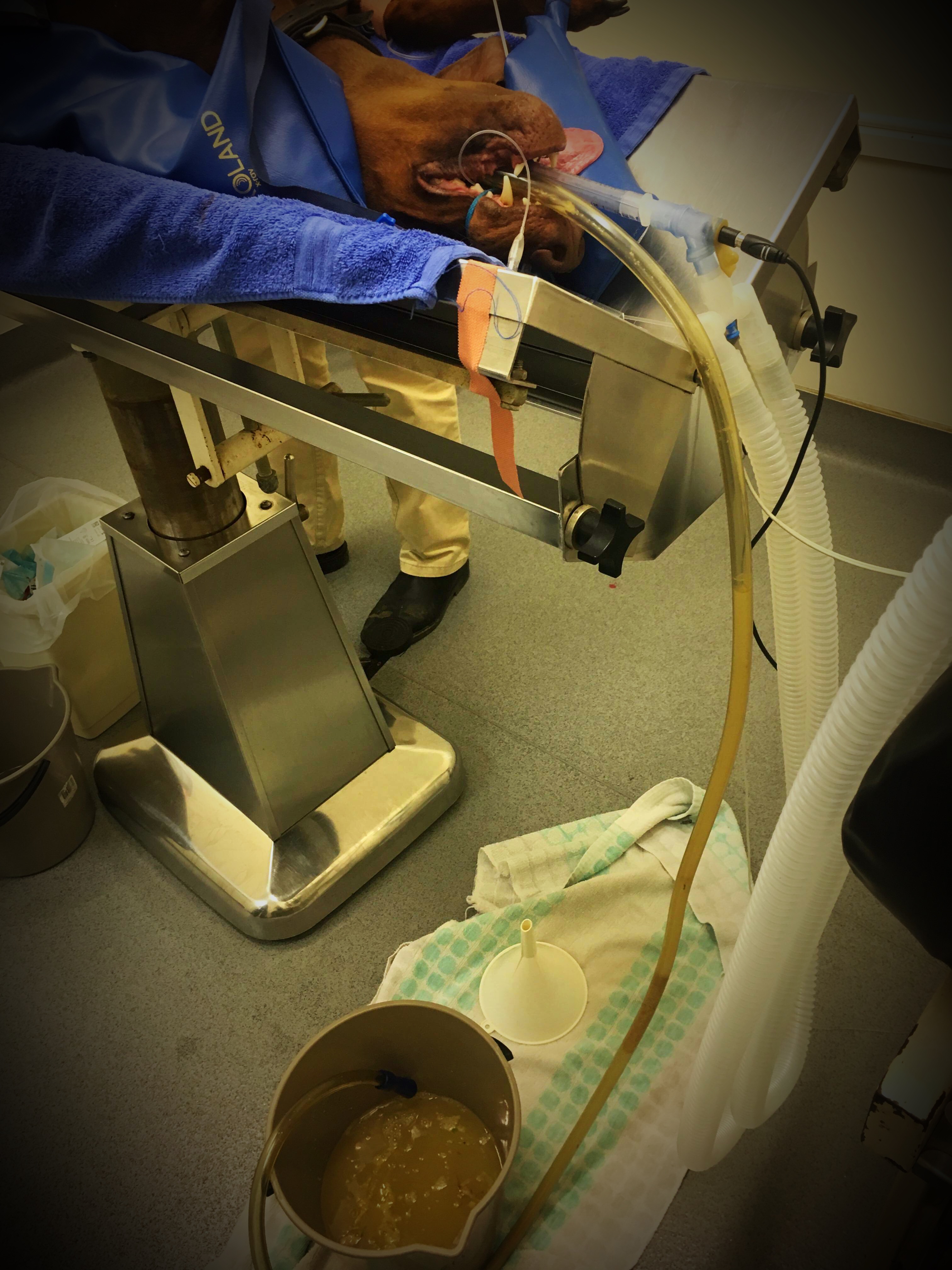Winston, the 5 year old Doberman is one lucky dog!
On Tuesday afternoon Winston’s owners noticed Winston’s stomach looked bloated and brought him straight into Pine Mountain Vet Clinic to see Dr Amy. On examination Winston was still bright as the owners had caught the condition quickly, but he was quickly deteriorating! His heart rate had increased, he was panting and on abdominal palpation he was very uncomfortable and would begin to retch.
Winston was rushed to xray and immediately Dr Amy, conclusively diagnosed him with gastric dilatation-volvulus (GDV) complex, due to the radiographs shows a large gas build up and a twisted stomach.
From then, a orogastric tube was passed into Winstons stomach, which is used to empty and deflate the contents. With some resistance (Food and gas, the tube passing was successful). From then, Winston was surgically prepared by Nurse Jacqui and Dr Jason began the surgery to untwist, asses the viability of organs and then perform a gastropexy (a procedure to surgically secure the stomach to the abdominal wall to prevent further twisting). Not only had Winston had a GDV, Dr Jason also found a large piece of sponge in his stomach which may have lead to a foreign body, or even caused the GDV itself!
Over the next 48 hours, Winston was monitored very closely, as the post operative monitoring can be just as risky as the surgery itself due to the occurrence of unusual heart beats (arrhythmias) which usually develop within the first 24–48 hours. As well as arrhythmias, dogs may also suffer from prolonged clotting times, hypoproteinaemia (requiring a plasma transfusion- of which Winston required) Electrolyte imbalances hyperlactataemia, anaemia and vomiting.
Winston, was a fighter, and because his parents caught the disease so quickly, his life was saved and returned home this afternoon! An incredible effort by the Pine Mountain Vet Team, Dr Amy, Dr Jason, Dr Scott, Veterinary Nurse Jacqui and Winston’s family, and of course, Winston!
So What is A GDV?
Bloat, also known as gastric dilatation-volvulus (GDV) complex, is a medical and surgical emergency and is fatal to 30 percent of the dogs it affects, even after extremely intensive treatment.
As the stomach fills with air, pressure builds, stopping blood from the hind legs and abdomen from returning to the heart. Blood pools at the back end of the body, reducing the working blood volume and sending the dog into shock. As the stomach flips, it drags the spleen and pancreas along with it, cutting off the blood flow. The oxygen-starved pancreas produces some very toxic hormones. One, in particular, targets the heart and stops it cold. In fact, a dog can go through successful treatment and seem to be out of danger, when suddenly the heart stops.
Even in the mildest case of bloat, this is extremely rare, dogs die without treatment.
Symptoms of GDV (Seek Veterinary Attention Immediately!)
- An enlargement of the dog’s abdomen
- Retching
- Salivation
- Restlessness
- Pale Mucous Membranes (gums)
- Weak but fast pulse
- Laboured Breathing
- An affected dog will feel pain and might whine if you press on his belly
Without treatment, in only an hour or two, the dog will likely go into shock. The heart rate will rise and the pulse will get weaker, leading to death.
Causes
The exact causes of GDV are unknown. A variety of factors, including genetics, anatomy, exercise and environment, are most likely to blame. Risk of bloat is correlated to chest conformation. Dogs with a deep, narrow chest — very tall, rather than wide — suffer the most often from bloat. Great Danes, who have a high height-to-width ratio, are five-to-eight times more likely to bloat than dogs with a low height-to-width ratio.
In addition to Great Danes, large- or giant-breed dogs at greatest risk include St. Bernards, Weimaraners, Irish Setters and Gordon Setters, Standard Poodles, and Doberman Pinschers. Males are twice as likely to bloat as females.
If a dog has relatives (parents, siblings, or offspring) who have suffered from bloat, there is a higher chance he will develop bloat.
Another factor that is believed to contribute to the development of GDV include ingestion of excessive amounts of food or water, delayed emptying of the gastrointestinal system, and too much activity after eating.
Diagnosis
A primary method of diagnosing GDV is imaging techniques, such as x-rays of the abdomen. Other tests may include a urine and blood tests to see if specific levels are elevated.
How is Bloat Treated?
Veterinarians start by treating the shock. Once the dog is stable, it is taken into surgery.
Firstly, the stomach needs to be deflated. A gastric decompression is performed, preferably with orogastric intubation, a process by which a tube is inserted through the patient’s mouth into the stomach. After these processes are complete and the patient is stabilized, surgical measures are then taken to return internal organs (such as the stomach and spleen) to their normal positions. Additional treatment may be needed to address any organ damage. Up to 90% of affected dogs will have this condition again, which is why we strongly recommended the stomach is surgicall secured to the abdominal wall (a procedure called a gastropexy) to prevent it from twisting in the future.
Prevention
As mentioned earlier, risk of bloat is correlated to chest conformation. Dogs with a deep, narrow chest — very tall, rather than wide — suffer the most often from bloat. Great Danes, Huskys, Malamutes, St. Bernards, Weimaraners, Irish Setters and Gordon Setters, Standard Poodles, and Doberman Pinschers are most at risk.
Certain dietary ingredients have been blamed over the years, but the data is inconclusive. This is because most large-breed dogs are fed a cereal-based diet, so making a statement that those diets are to blame is difficult. However, we do know that foods containing soybean meal or having oils or fats in the first four ingredients are four times more likely to suffer from GDV.
Over the years, there have been studies that show that food bowls on the floor cause more cases of bloat, but this study has been ruled out, and elevated food bowls are now known to be just as much of a risk. With these conflicting results, a solid recommendation can’t be made.
Dogs fed one meal a day are twice as likely to bloat as those fed two meals a day. Rate of eating is also a contributor. Fast eaters have five times the risk than dogs that are slow eaters. Using bowls with fingers (or center posts) or putting large rocks in the bowl slows dogs down physically.
Stressed dogs and those that are hyperactive are more likely to bloat. Separating dogs at feeding times may help reduce anxiety and stress surrounding food. Unhappy or fearful dogs are twice as likely to bloat as those that are happy.
Surgical Gastropexy is the best way to prevent a GDV from occurring in your dog.
We can’t prevent all cases of bloat, but by implementing some of the above techniques, you may be able to reduce your dog’s risk. If your dog shows signs of bloat, take him to a veterinarian or an emergency pet clinic immediately.








